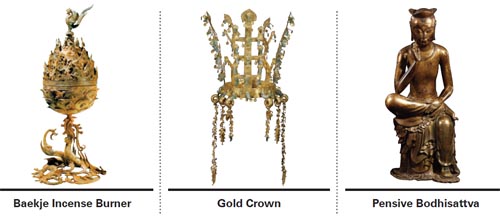Amid the toasts, treasures from Korea’s past

At least that’s what the museum hopes for. In celebration of the G-20 Summit, the National Museum of Korea recently designated 20 masterpieces (dubbed the “M20”) among its vast collection of cultural and historical artifacts. Fourteen of them will be displayed in the first-floor hall of the museum, called the “Path to History,” which will be used as the reception hall for the event this evening.
At the entrance of the reception hall, the 6-7th century Baekje Incense Burner will welcome the leaders and their entourages. This incense burner, used in royal court ceremonies, has a stand in the form of a dragon, a body formed as a lotus bud, a lid with elaborate carvings of the otherworld and fairy musicians and a freestanding phoenix on top of the lid. It is regarded as a prime example of Korea’s ancient metal crafts.
The 7th-century gilt-bronze “Pensive Bodhisattva,” who appears to be immersed in deep contemplation with one leg placed across his lap and with a mystic, elegant smile, will also be at the entrance.
Then, the 5th-century “Gold Crown, Belt and Crown Ornaments”, from the Silla tomb of Hwangnamdaechong, may attract the eye of attendants, along with the sparkle of their dangling ornaments.
The leaders and their entourages may also notice a 12th-century “Metal Type” display, which shows how books were printed with metal type during the Goryeo Period, 200 years before German Johannes Gutenberg’s (1398-1468) printing press.

“The selected masterpieces represent different periods, ideologies and forms of expression in the formative arts, but nevertheless they are characterized by a consistent artistic sense,” the museum said in an introductory note about the M20. “They are imbued with the Korean spirit.”
The “10-story Pagoda” from the Goryeo Period, another item on the M20 list, has been part of the “Path to History” since the relocation of the National Museum to the current site in Yongsan in 2005. The marble pagoda, built in 1348, will look down on the world leaders at the reception.
But some paintings and similar works on the M20 list will not be displayed at the reception hall, “because they are vulnerable to strong [light], which will be needed at the reception,” according to Lee Hyun-ju, a public relations officer at the museum.
These works include the 5th century “Mural Fragment of an Equestrian Figure” from a tomb of the Goguryeo Dynasty; the 18th-century “Album of Genre Paintings” by the Joseon master Kim Hong-do, known as one the best painters in Korean history; the 18th-century panorama “Endless Rivers and Mountains” by Joseon landscape painter Yi In-mun; the 18th-century “Album of a Journey to Songdo” by Joseon scholar and artist Kang Se-hwang; and the 18th-century “Complete Map of the Eastern State,” which is known for its precision.
The 8th-century stone sculptures “Maitreya Bodhisattva and Amitbha Buddha” from the Unified Silla period will also remain in their original exhibition room because it is too difficult to move them.
“It is a good idea to use the museum for the summit, so that the leaders of other countries can understand Korea’s cultural heritage,” said Jean-Jacques Aillagon, president of Chateau de Versailles, when he visited Seoul last week for a special exhibition of Chateau de Versailles art at the Seoul Arts Center.
The other artifacts on the M20 list that will be on display at the reception hall are: 10,000-year-old comb-pattern pottery from the Neolithic Age; Korea’s largest polished stone dagger from the Bronze Age; 3rd-century duck-shaped pottery vessels to carry beverages for ceremonial or memorial services; 6th-century ritual horse-rider-shaped vessels of Silla; a 7th-century royal-palace-shaped container from the East Pagoda at the Monastic Site of Gameunsa; and a 12th-century ritual jug called Kundika, which was known as the essence of Goryeo-period metal crafts.
By Moon So-young [symoon@joongang.co.kr]










with the Korea JoongAng Daily
To write comments, please log in to one of the accounts.
Standards Board Policy (0/250자)